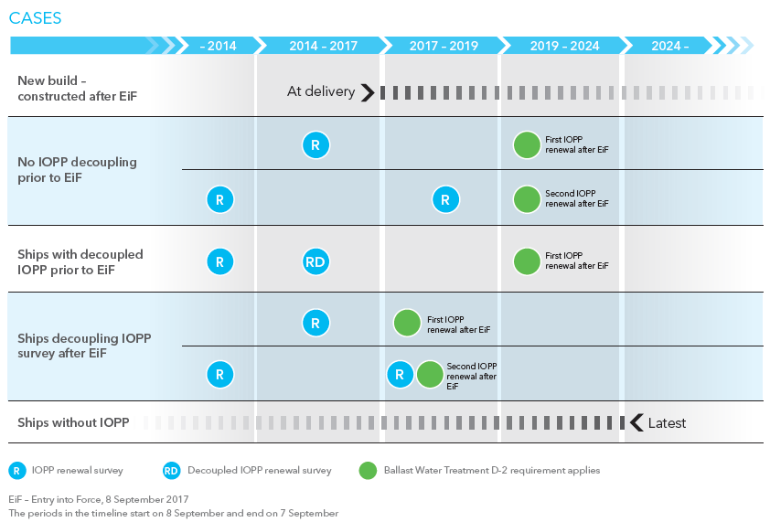IMO Pushes Back Ballast Water Compliance Dates
The IMO's Marine Environment Protection Committee (MEPC) finished up its 71st meeting Friday with new resolutions on ballast water management and carbon dioxide emissions.
The most noteworthy resolution to emerge from MEPC 71 was a new implementation scheme for ballast water management (BWM) requirements. The new plan requires compliance with the Ballast Water Management Convention standards at the first or second IOPP renewal survey after September 2017, subject to certain conditions. This will allow existing vessels to continue operating without a retrofitted ballast water treatment system until as late as 2024, depending upon the particular timeline of their IOPP surveys – up to two years later than previously allowed, and twenty years after the Convention was first adopted.
 New BWMC implementation timeline (graphic courtesy DNV GL)
New BWMC implementation timeline (graphic courtesy DNV GL)
MEPC has not yet adopted the new resolution, but it expects that the plan will be formally in effect by 2019. The resolution calls on all parties to acknowledge the revised timeline until it is officially in force.
The delay was not unexpected. Multiple flag states, including Brazil, Cook Islands, India, Liberia, Norway and the U.K., had called for IMO to push back the implementation timeline for the BWMC. While it will come as a relief for some financially-pressed shipowners, it may also have implications for ballast water treatment system manufacturers, who could see reduced demand for their products in the near term.
For vessels trading to the United States, the situation is more complex. This week, the U.S. Coast Guard issued a warning that the IMO guidelines on the Ballast Water Management Convention do not apply to America's own ballast water laws. The agency reminded operators that when vessels are within the territorial waters of the United States, they must discharge via a USCG-approved ballast water management system, an approved alternate management system, a shoreside facility, or not at all. Noncompliance with American ballast water regulations can result in delays, inspection deficiencies and civil enforcement action.
A draft outline for a CO2 strategy
MEPC did not adopt any specific goals or targets for shipping's future emissions of greenhouse gases, but it did note that its intercessional working group on greenhouse gas emissions has created a draft outline. An initial IMO CO2 strategy could include the following sections:
- Preamble/introduction/context, including emission scenarios
- Vision
- Levels of ambition / Guiding principles
- List of candidate short-, mid- and long-term further measures with possible timelines and their impacts on States
- Barriers and supportive measures; capacity building and technical cooperation; R&D
- Follow-up actions towards the development of the revised strategy
- Periodic review of the Strategy

that matters most
Get the latest maritime news delivered to your inbox daily.
The strategy, referred to as the "Roadmap" for developing CO2 targets, would include three phases: first, the collection of fuel oil consumption data over the period from 2019-2021; second, a study to analyze this data; and third, "decision making on what further measures, if any, are needed."
If IMO does not adopt a CO2 control strategy by 2021, the European Union will include shipping within its regional Emissions Trading Scheme (ETS) – an outcome that the industry would prefer to avoid. The International Chamber of Shipping recently called on IMO to develop and adopt "aspirational targets" for emissions reductions, noting that there is a "finite amount of time in which to make the progress that will be necessary to ensure that IMO remains in full control of how GHG emissions from international shipping should best be addressed."
